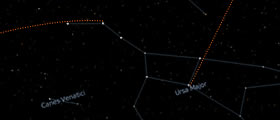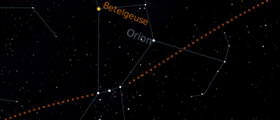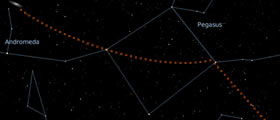Pointers
6.3 - Understand the use of asterisms as pointers to locate specific objects in the night sky, including:a) Arcturus and Polaris from the Plough
b) Sirius, Aldebaran and the Pleiades from Orion’s Belt
c) Fomalhaut and the Andromeda galaxy from Square of Pegasus
Some constellations and asterisms form natural pointers toward other stars.
Plough
The two stars on the pan end of Ursa Major point (from bottom, Merak, to top Dubhe) to Polaris in Ursa Minor.
This is the star that marks the celestial north pole and has been useful to navigators for centuries because it points north. If you were at the North Pole, Polaris would be directly above your head. This star is a small fraction away from the North Pole but it is pretty near.
The Plough is also useful to find Arcturus, a red star in Bootes. Follow the path of the 'handle' of the Plough to find Arcturus.
Orion
The stars in the belt of Orion can point westwards and down to the brightest star Sirius, the Dog Star, in the constellation of Canis Major (The Great Dog).
If you follow the path of the 3 stars in the opposite direction you will come to the bright red star Aldebaran in Taurus and the Pleiades Cluster.
Square of Pegasus
If you use the bottom right and top left stars of the square you can use a line to find the Andromeda Galaxy which is barely visible on a clear night in an area of low light pollution.
Using the top right and bottom right stars of the square you can follow the line down to Fomalhaut. Bear in mind that Fomalhaut is only visible from southern parts of the UK for a few months of the year and will be very near the horizon.
Animation
Links
- Natural Navigator How to navigate using the Stars
- Kids Astronmomy Finding Polaris
- Catching the Light by Jerry Lodriguss Ursa Major and Ursa Minor




 | © All Rights Reserved |
| © All Rights Reserved |